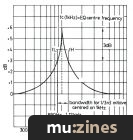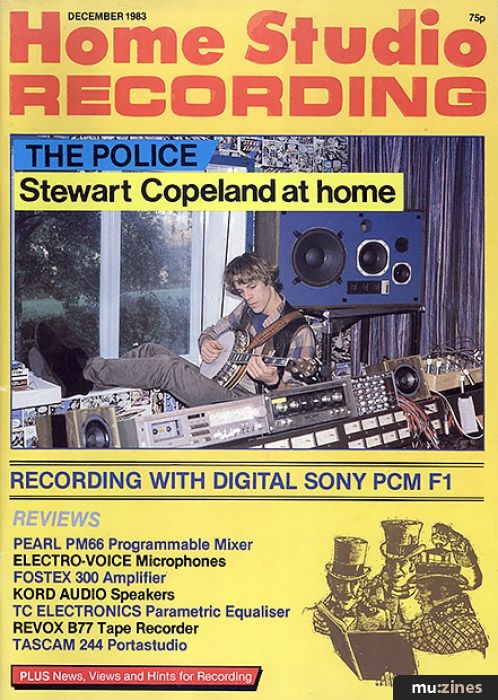Magazine Archive
Home -> Magazines -> Issues -> Articles in this issue -> View
Active Speaker Systems (Part 3) | |
Article from Home & Studio Recording, December 1983 | |
Most of you will have heard of active speakers, even if you know of the technique by another name, such as 'Bi-amping'. A competently engineered active system is always superior to an equivalent system with passive loudspeaker crossovers. So much has never been in doubt, but only in the past four years have such systems arrived on the market at affordable prices.
We aim to review some active speakers soon, so here explains what the process of 'activation' is all about, and outlines the advantages.

If there was a drive unit which could reproduce the whole audible range of frequencies equally at high levels, and without any other scruples, there'd be no need for the active approach - nor indeed for any form of crossover at all. The nearest we can get to this ideal is with electrostatic speakers, but these suffer from serious intrinsic SPL (sound pressure level) limitations, aren't accurate in the low bass, and prices begin at £1000. Without a plausible full-range drive unit, we're stuck with using 2 or 3 separate units, each chosen for its ability to competently reproduce a segment of the audio band.
Bass drivers (woofers) have heavy, large-area cones, and rugged, high power voice coils which are designed to suit low frequency punishment. Midrange drivers tend to feature special cone materials for accuracy of reproduction in the zone where the ear is most sensitive. Otherwise they're a compromise between the woofer's and tweeter's mechanics, the cone for instance being of medium diameter and weight. The treble driver (or tweeter) has a small diameter cone to maintain wide dispersion; the short wavelengths at top frequencies (a matter of inches) would otherwise be concentrated dead on-axis, thereby making the choice of listening position critical. At the same time, the voice coil and cone are necessarily lightweight, precise - and fragile: remember that reproducing a frequency of 20kHz calls for efficient speaker movements up to 20,000 times per second....
The technology of specialised drivers (ie. woofers, tweeters, etc.) is well developed - the problems being when we try to get 2 or 3 drivers to work together as if they're a single loudspeaker. This is known as integration, and aside from being concerned with a coherent soundfield, it has a crucial bearing on the stereo sound stage. Avoiding any conceptualisation for the moment, the necessary gizmo (or 'blackbox') to achieve this is a combining unit - at least from the drivers' viewpoint. However, if we look at the 'blackbox' from a different angle, from the front-end of the system, the gizmo's action is clearly that of a 'frequency (or more correctly spectrum) dividing' unit, more often known as a crossover.
In having some prior knowledge of what a crossover does, it's easy to make the mistake of concentrating exclusively on the frequency division aspect. To understand crossovers properly though, you need to keep in mind that the divided-up sound has also to be reassembled (integrated) by the speaker unit considered as a whole. A good crossover splits up sound (like a tent frame) for ease of handling. Then at the speaker (campsite) the parts can be accurately joined together to recreate the original sound (tent).
Crossovers
Passive crossovers are usually sited between the power amplifier and the 2, 3, or 4 drive units. In this position, the crossover's filtering action takes place at high power, using large resistors, capacitors and inductors. Because the filtering effect of these components involves no external power source, the assembly is passive - hence the term passive crossover. For a 3 way crossover, the bass driver feed features a low pass filter, which removes frequencies above the bass regions. Conversely, the tweeter's signal comes via a high pass filter. For the midrange, a combination of low and high pass filtering provides a bandpass response.
Although this arrangement means only a single amplifier is needed to power the several drivers making up the composite speaker, it exhibits several disadvantages when we want to handle lots of power, whilst desiring high quality results. Put simply, passive crossovers begin to show their limitations in studio monitoring applications. Part of the difficulty stems from the location of the crossover - not the fact that it's passive. Wired between the amplifier and the drive units, the latter's impedance variations with frequency upset the filtering action, whilst the need for the crossover components to have high power handling capabilities, without suffering distortion effects, only adds to the difficulties.
Wiring a passive crossover assembly in series with the line level signal before the amplifier would overcome these problems in a stroke, the snag being that you now need one amplifier per drive unit - say 3 stereo amps to drive a stereo, three unit speaker system. But without adding to this minor pitfall (and good, high-power amps needn't be expensive today), we can add to the list of benefits by retaining line level, the location, and simply changing over to active technology.
Activation
An active filter uses an amplifying stage (be it built around tubes, discrete transistors, or analogue chips) and a small quantity of electricity to overcome the losses inherent in passive filters. At the same time, with feedback techniques, complex filters using only (low cost) resistors and capacitors to determine the frequency response are feasible; inductors needn't be used. The term active arises because these filters (like most circuitry) need a power source to operate, but otherwise, they're based on the same principles as their passive counterparts, with the benefits of higher accuracy and more predictable performance slung in.

24dB per octave 'active' crossover from Brooke Siren Systems.
An active crossover is basically a box then, operating at line levels, and containing sets of active filters to provide the low, high and bandpass outputs to each driver, each output going via a separate power amplifier. In the ballpark, the practical advantages of this arrangement include cleaner, more transparent sound reproduction, and the potential for driving the system much harder before distortion sets in. Around 50 to 75% of the energy in normal music program is fed to the bass drivers, therefore amplifier overload (clipping) will usually occur initially in the bass amplifier(s).
Using an active crossover, the resultant high-order harmonics (high frequency error signals produced when an amp is overloaded) are fed solely to the bass drivers. These are generally incapable of reproducing high frequencies efficiently, and what distortion remains is masked by legitimate and undistorted high frequency signals. The same argument can be applied to the remaining drivers, with qualifications, but what's important is that the bass amp may be run into clipping without the noises of distress familiar to users of full-range passive systems. So whilst we need extra amplifiers, the sum of the individual amplifier powers needn't be any greater than before, and there's still the bonus of being able to drive systems 3 to 10dB harder, ie. louder for a given amount of power/handling capability/distortion.
Typically, with active amplifier power totalling 300 watts, 10dB 'overdrive' makes reasonably clean sound at an SPL equal to a 3kW system - that's double the loudness at 300 watts. From another angle, it's like raising the sensitivity of the drive unit by 10dB. This is obviously valuable when we want to extract monitoring levels from high quality drivers, which tend to have mediocre sensitivities. Aside from effective sensitivity benefits, active arrangements offer direct benefit in another region, for with the frequency division being done at line levels, the drive units and amplifier no longer suffer interaction with the crossover, whilst the crossover is saved from the interactive effects of the drivers. And with the drive units now connected directly to their respective power amplifiers, the drivers' behaviour is more tightly confined to reproducing the signal presented from the amp - with fewer ad-lib interpretations. In particular, the bass sound on active systems is noticeably tightened, and smoother too.
Advantages
There are a number of other advantages, but all but one of these needn't bother us here - they're mostly concerned with making design and application easier, and facilitating special techniques, such as servo-feedback, centre bass, and phase amplitude EQ. Amongst these, the -24dB/octave slope is the most important gemstone. You can attain a -24dB/octave rate of attenuation (also known as a 4 pole or 4th order slope because it's synthesised using four 6dB per octave filter sections) with a passive crossover, but it involves complicated, convoluted filter circuitry; even if it ends up working as intended, a large proportion of the amplifier power tends to be soaked up. In the active version, all this is achieved with less grief - an accurate 24dB/octave active filter can be designed in a few minutes; nor are there any power losses.
-24dB/octave systems are desirable for their phase integrity - unlike speakers with -12 or -18dB/octave crossovers, there's a minimal phase difference between, say the bass and midrange drivers at the crossover point, where they're both contributing audible output. Clearly, this helps the drivers to integrate. The phase coherency at the crossover point also obviates signal enhancement/cancellation, so preventing peaks or dips in the response in this region. Crossovers using the basic -6dB/octave slope also feature this phase coherency, but in general, this rate of attenuation is too shallow (ie. attenuates too slowly; -6dB/octave corresponds to a halving in signal voltage for a twofold change in frequency) to be used with most drive units, especially on Rock Music.
Series - "Monitoring"
Read the next part in this series:
Monitoring - Active Crossovers (Part 4)
(HSR Jan 84)
All parts in this series:
More with this topic
When Is A Room - Sound Training |
A Shiftin' air affair - Bass Traps |
Sound Systems For Synthesizers |
Sound Spaces - Getting Studio Acoustics Right |
Sound Absorbers - Acoustics (Part 1) |
Reflected glories - Studio design |
Room EQ, Myth or Legend? (Part 1) |
Analysing the Spectrum - Audiosource RTA1 Spectrum Analyser |
Small Studio Acoustics |
Urban decay - Part wall |
Contact Miking Real Drums |
 Shut Up! - How to soundproof a rehearsal room (Part 1) |
Browse by Topic:
Acoustics
Publisher: Home & Studio Recording - Music Maker Publications (UK), Future Publishing.
The current copyright owner/s of this content may differ from the originally published copyright notice.
More details on copyright ownership...
Feature by Ben Duncan
Help Support The Things You Love
mu:zines is the result of thousands of hours of effort, and will require many thousands more going forward to reach our goals of getting all this content online.
If you value this resource, you can support this project - it really helps!
Donations for April 2024
Issues donated this month: 0
New issues that have been donated or scanned for us this month.
Funds donated this month: £7.00
All donations and support are gratefully appreciated - thank you.
Magazines Needed - Can You Help?
Do you have any of these magazine issues?
If so, and you can donate, lend or scan them to help complete our archive, please get in touch via the Contribute page - thanks!
















